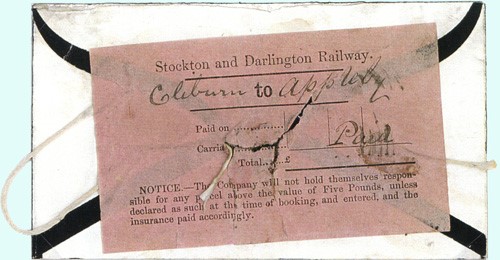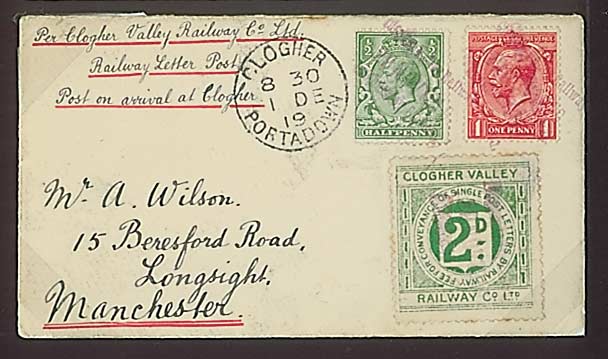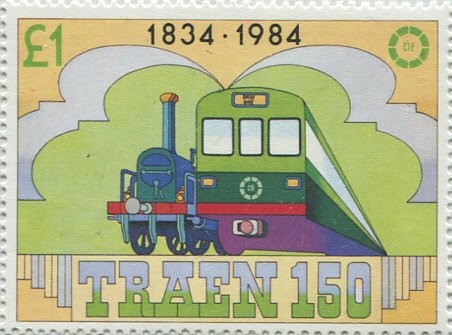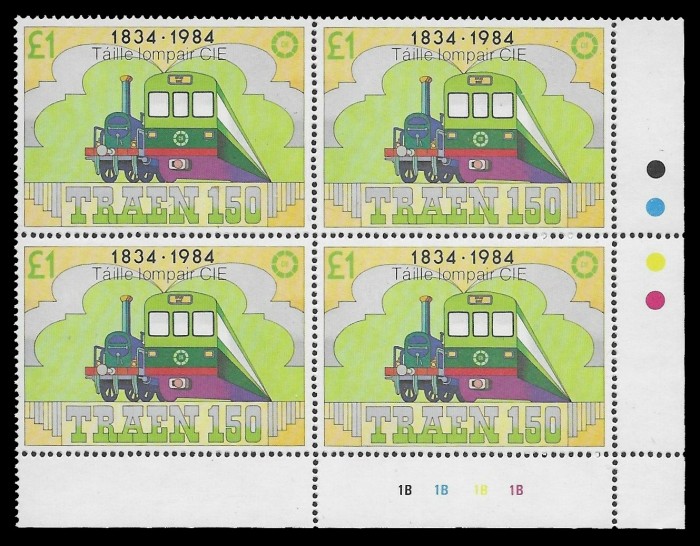Introduction:
The history of rail transport in Ireland mirrors closely that of England and the Irish railway companies (in line with their English counterparts) also eventually carried mail. This included letters and parcels as they competed directly with the Post Office in each country.
By its peak in 1920, Ireland had 3,500 route miles of railway track (5,600 km) and, in order to administer their postal services, many of the railway, light railway and tramway companies issued their own stamps.
- MAP OF IRELAND: Viceregal Commission on Irish Railways 1906
Railway Letters:
Very shortly after the introduction of rail passenger and rail services, various railway companies experimented with the carriage and delivery of letters, packages and parcels.
- The Post Office had a monopoly on letters
- The Post Office did not have a parcel delivery service, and when railway companies introduced such a service, people found a way to use the parcel delivery services to fraudulently deliver letters by train
- Large envelopes / small packages were somewhat of a ‘grey area’
- The railways innovated by insisting a letter tied by string was a ‘parcel’ and therefore not subject to the Post Office monopoly
- Of course, the Post Office was not happy about this practice, and tried strenuously to stamp it out – unsuccessfully!
- Examples are known of ‘string letters’ as early as the 1840s

The first Railway Letters – String Letters. This one (dated 16 March 1864) is from England’s Stockton & Darlington Railway.
Some time around the year 1870, further attempts were made at introducing a ‘courier service’ whereby parcels were delivered to the addressee by a railway clerk – presumably they had plenty of time to do so in between rail services.
- The sender would ‘post’ their letter / parcel at their nearest railway station
- The railway company applied an adhesive label to denote “Carriage Paid”
- The charge was sixpence
- The addressee’s nearest railway station clerk would deliver the package by hand
The Cork & Bandon Railway was an early adapter and examples are known. It is reported other rail companies followed suit but no examples have been recorded. This ‘courier service’ which was against Post Office regulations and it was quickly suppressed.
- Links to illustrated articles will be provided when Irish examples are found
Railway Letter Stamps:
Nevertheless, the railway companies persisted in their efforts to provide local letter and parcel delivery services in their area and, by 1891, the Railway Letter Service was introduced. As per agreement with the British Post Office, railway companies were allowed to use special ‘railway stamps’ of a common design for sending ‘urgent’ letters by rail. This agreement limited the railways to accepting:
- Single Inland Post Letters, not exceeding 1oz. in weight
- These stamps – not exceeding 2d – were used as ‘additional postage’ on top of the usual 1d Post Office rate for inland letters.
- In January 1920, this was raised to 3d
- In September 1920, the fee was raised again – to 4d
- These increases were signified either by overprint, or by manuscript (ms.)
- From October 1920, with permission from the Post Office, Railway Letter stamps were gradually replaced by Railway Parcel stamps
Philatelic Railway Covers:
The 19th C provided us with a wealth of gentleman collectors and stamp dealers – some of whom designed their own special envelopes. While not as sophisticated as today’s mass-produced First Day Covers issued by the Philatelic Bureaux of today’s state-run post offices, they are nonetheless considered ‘philatelic’ items and are not as scarce as the much more sought after ‘commercially used’ envelopes with railway stamps on them.
These ‘special’ covers/envelopes are often quoted at auction but buyers should note they are not any where near as scarce as ‘genuine’ commercial covers of the day. Names to watch out for, include the following:
- H. L’Etrange-Ewen (London)
- Ewen’s Weekly Stamp News (London)
- E.C. Shearman (London)
- Rev. L. Graham (Manchester, Stoke-on-Trent, Newark)
- W.M. Grimshaw (Sussex)
- A. Wilson (Manchester)
Although these collectors/dealers were based in Britain, they utilised contacts in Ireland to post their ‘return’ envelopes back to them, along with the appropriate railway stamp(s) of the day, cancelled by the railway company’s postmark.

CLOGHER VALLEY RAILWAY Co 1919 (29 Nov) Wilson envelope from Aughnacloy Station, Co Tyrone to Manchester franked with Clogher Valley 2d green, Type II stamp
Irish Railway Letter Stamps:
Not all of the Irish railway companies followed suit, but many did and they make for a very interesting specialist Irish philatelic study. Since most of the Irish railway companies were small, and had a limited customer base, they ordered their railway stamps in small quantities – giving rise to a variety of printings, a variety of colours, and a variety of shades of colour.
- There were also a series of mergers and acquisitions which led to name changes
- Some of the smaller railways / tramways do not appear to have issued stamps
- They are included on the basis that some may be found in the future

Most of the Irish Railway stamps adhere to this one template design, but there are many variations in denomination, colour, shade, overprint and manuscript denominations.
Thus far, Irish railway philatelists have arranged them into groups by:
- Railway Company
- Die Type (design)
- Die Variety / Error
- Denomination
- Overprint
- Basic Colour
- Shade
Standard ‘Irish Gauge’ Railways:
- Belfast & Co Down Railway
- Issued Railway Letter Stamps from 1891-
- All but the line between Belfast and Bangor was closed in the 1950s
- Some of it has been restored near Downpatrick as a heritage line
- Belfast & Northern Counties Railway
- Issued Railway Letter Stamps from 1891-
- Nationalised in 1948, sold to Ulster Transport in 1949 and kept open
- Cork, Bandon & South Coast Railway
- Issued Railway Letter Stamps from 1891-1920
- It became part of the Great Southern Railway in 1924
- Dublin, Wicklow & Wexford Railway
- Issued Railway Letter Stamps from 1891-1906
- The DW&W became Dublin & South Eastern Railway (D&SER) in 1906
- Dublin & South Eastern Railway
- Issued Railway Letter Stamps from 1911-1922
- The company previously traded under the names:
- Waterford, Wexford, Wicklow & Dublin Railway (WWW&DR) to 1848
- Dublin & Wicklow Railway (D&WR) to 1860
- Dublin, Wicklow & Wexford Railway (DW&WR) until 1906
- The D&SER joined with the Great Southern Railway on 1 January 1925
- The resultant company was known as Great Southern Railways
- Great Northern Railway Company (Ireland)
- Issued Railway Letter Stamps from 1891-
- It was formed in 1876 by a merger of the Irish North Western Railway (INW), Northern Railway of Ireland, and Ulster Railway
- The governments of Ireland and Northern Ireland jointly nationalised the company in 1953, and the company was liquidated in 1958
- Assets were split on national lines between the Ulster Transport Authority and Córas Iompair Éireann
- Great Southern & Western Railway
- Issued Railway Letter Stamps from 1891-
- The largest of Ireland’s “Big Four” railway networks
- An Act passed by the Dáil Éireann in 1924 merged the GS&WR with the Midland Great Western Railway, the Cork, Bandon & South Coast Railway and most other railways wholly within the Irish Free State to form the Great Southern Railway
- In 1945 further amalgamation with the Grand Canal Company and the Dublin United Tramway Company created Córas Iompair Éireann (“Irish State Transport Company”)
- CIÉ was nationalised in 1950
- In 1987, it was divided into separate rail and road companies
- Since then, the railways have been operated by Iarnród Éireann (“Irish Rail”)
- Midland Great Western Railway
- Issued Railway Letter Stamps from 1891-1920
- Third-largest rail operator in Ireland
- Absorbed into the Great Southern Railways in 1924
- Midland Railway Northern Counties Committee
- Issued Railway Letter Stamps from 1906-1920
- Issued Railway Letter Stamps from 1906-1920
Irish ‘Narrow Gauge’ Railways
In recent years, the railway stamps of the smaller, independent railway companies have seen a sharp rise in value when sold at auction. This is in line with other areas of Irish philately where prices have been consistently rising just ahead of inflation. As such, it would appear that collecting Irish stamps is, apart from being an interesting and educational hobby, also a financially rewarding investment too.
In theory, they are far more scarce than the issues of the larger, better funded ‘standard gauge’ railway companies that typically operated in more populous areas and their hinterlands.
- Ballycastle Railway
- Issued Railway Letter Stamps from 1891-1919
- Taken over by the Northern Counties Committee (NCC) in 1924
- Line closed in July 1950
- Ballymena & Larne Railway
- No railway stamps known to have been issued
- Ballymena, Cushendall & Red Bay Railway
- No railway stamps known to have been issued
- Bessbrook & Newry Tramway
- No railway stamps known to have been issued
- Castlederg and Victoria Bridge Tramway
- Issued Railway Letter Stamps from 1897-1919
- Cavan & Leitrim Light Railway
- Issued Railway Letter Stamps from 1893-1920
- Cavan, Leitrim & Roscommon Light Railway
- Issued Railway Letter Stamps from 1891-1901
- Cavehill & Whitewell Tramway
- No railway stamps known to have been issued
- Clogher Valley Railway
- Issued Railway Letter Stamps from 1898-
- Clogher Valley Tramway
- Issued Railway Letter Stamps from 1891-1898
- Clonakilty Extension Light Railway
- No railway stamps known to have been issued
- Cork & Macroom Direct Railway
- Issued Railway Letter Stamps from 1894-
- Cork & Muskerry Light Railway
- No railway stamps known to have been issued
- Cork, Blackrock & Passage Railway
- Issued Railway Letter Stamps from 1892-
- County Donegal Railways Joint Committee
- Issued Railway Letter Stamps from 1906-1920
- The Glenties branch closed in 1947
- The Strabane-Derry line closed in 1954
- The remaining passenger services ended on 31st December 1959
- Issued Railway Letter Stamps from 1906-1920
- Donegal Railway Company
- Issued Railway Letter Stamps from 1895-
- Dublin & Blessington Steam Tramway
- No railway stamps known to have been issued
- Dublin & Lucan Electric Railway 1900–1925
- No railway stamps known to have been issued
- Dublin United Tramways Co
- No railway stamps known to have been issued
- Issued Railway Parcel Stamps from
- Dundalk, Newry & Greenore Railway
- Issued Railway Letter Stamps from 1891-
- Finn Valley Railway Company
- Issued Railway Letter Stamps from 1891-1895
- Finn Valley & West Donegal Railways
- Issued Railway Letter Stamps from ?
- Giant’s Causeway, Portrush & Bush Valley Railway & Tramway
- No railway stamps known to have been issued
- Kanturk & Newmarket Railway Company
- Issued Railway Letter Stamps from 1891-1892
- Listowel & Ballybunion (Lartigue) Railway
- No railway stamps known to have been issued
- Londonderry & Lough Swilly Railway
- Issued Railway Letter Stamps from 1893-
- Schull & Skibbereen Railway
- No railway stamps known to have been issued
- Sligo, Leitrim & Northern Counties Railway
- Issued Railway Letter Stamps from 1891-
- South Clare Railway
- No railway stamps known to have been issued
- Timoleague & Courtmacsherry Railway
- No railway stamps known to have been issued
- Ballinascarthy Railway
- Operated by the Timoleague & Courtmacsherry Railway
- No railway stamps known to have been issued
- Tralee & Dingle Light Railway & Tramway
- Issued Railway Letter Stamps from 1897-
- Waterford & Central Ireland Railway
- Issued Railway Letter Stamps from 1891-1900
- Waterford & Limerick Railway
- Issued Railway Letter Stamps from 1891-1896
- Waterford & Tramore Railway
- Issued Railway Letter Stamps from 1891-
- Waterford, Dungarven & Lismore Railway
- Issued Railway Letter Stamps from 1891-1898
- Waterford, Limerick & Western Railway
- Issued Railway Letter Stamps from 1896-1901
- West Clare Railway (South Clare Railway was built separately, but managed by WCR)
- Issued Railway Letter Stamps from 1891-
- In 1925, the West Clare Railway was merged into Great Southern Railways
- In 1945, the GSR was taken over by Córas Iompair Éireann (CIÉ)
- The line closed on 1st January 1961
C.I.E. Railway Stamps:
On 25th June 1984, Ireland’s state-owned and operated railway company (Córas Iompair Éireann, otherwise known as CIÉ) issued stamps to celebrate the 150th anniversary of the first Irish railways.
Since CIÉ did not have a license to issue postage stamps in Ireland, the stamp was quickly withdrawn (after 24 hours), following complaints from An Post (the Irish Post Office). The Post Office objected that the design looked too much like a postage stamp and insisted on an overprint to indicate its exclusive use for railway letters.

1984 CIÉ Railway Stamp – 150th Anniversary of the Dublin & Kingstown Railway
- Designer: Peter Sluis
- Printer: Irish Security Stamp Printing, Dublin
- Lithography in sheets of 20 (5 rows of 4)
- Perforations: 14¼ x 14¾
- Number Printed: 40,000
- c. 5,000 sold on the day
- c. 35,000 of these were ‘overprinted’ later (see stamp below)
The remaining stock of stamps were then overprinted “Taille Iompair Éireann” to comply with An Post’s legal and licensing requirements. This overprint (located top centre, just below the date) translates as “Transport Fee CIÉ”

1984 CIÉ overprint “Taille Iompair CIE” plate block of 4, with ‘traffic light’ colour print controls.
CIÉ will celebrate its 75th Anniversary in 2020 but, sadly, An Post will not issue stamps commemorating this anniversary. Somehow, a set of 4 stamps commemorating a British television sitcom from the 1990s (Hat Trick Productions for Channel 4, Father Ted) has been deemed more important.
